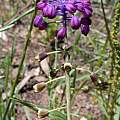Leopoldia is a genus in the Hyacinthaceae family with species that were formerly and sometimes still in included in the genus Muscari. Species are on the whole much taller plants than other Muscari subgroups with the flowers more widely spread on the raceme. The fertile flowers are longer, usually urn-shaped or tubular with angular 'shoulders' just below the constricted mouth. The colour is usually some shade of whitish, yellowish, greenish or brown, never blue, although there is often a conspicuous tuft of bright violet, blue or pinkish sterile flowers at the top of the raceme. This group or genus blooms later in the season, in late spring or early summer. They are relatively easy to cultivate in warm sunny situations.
Leopoldia bicolor is a species native to Israel. Photos by Gideon Pisanty.
Leopoldia comosa, syn. Muscari comosum is widespread in southern Europe eastwards to Turkey and Iran and has been in cultivation for many centuries, perhaps because of its culinary use. For this purpose, the plants are harvested before flowers appear. The flower head is a pallid purple; flowers when bloomed turn a shade of brown. Flowers have a musty odor, not very pleasant. Bulbs divide well and in some places escaped cultivation. The first two photos by Nhu Nguyen. The next three photos from Mary Sue Ittner show the bloom sequence of the plants in a pot. The last photo from Janos Agoston shows the bulbs.
Leopoldia comosa 'Plumosum', syn. Muscari comosum 'Plumosum' is a cultivar, deriving its name from the Latin for 'feathered'. It is composed almost entirely of sterile florets, like the florets atop the type species. Series of photographs by David Pilling showing the development of one stem and a shoot appearing in February. For more discussion see here.
Leopoldia eburnea 'eburneais? a species from Israel. Photo by Gideon Pisanty.
Leopoldia longipes is a species from Israel. Photos by Gideon Pisanty.
Leopoldia longipes subsp. Negevensis photo of fruiting plant by Gideon Pisanty.


















